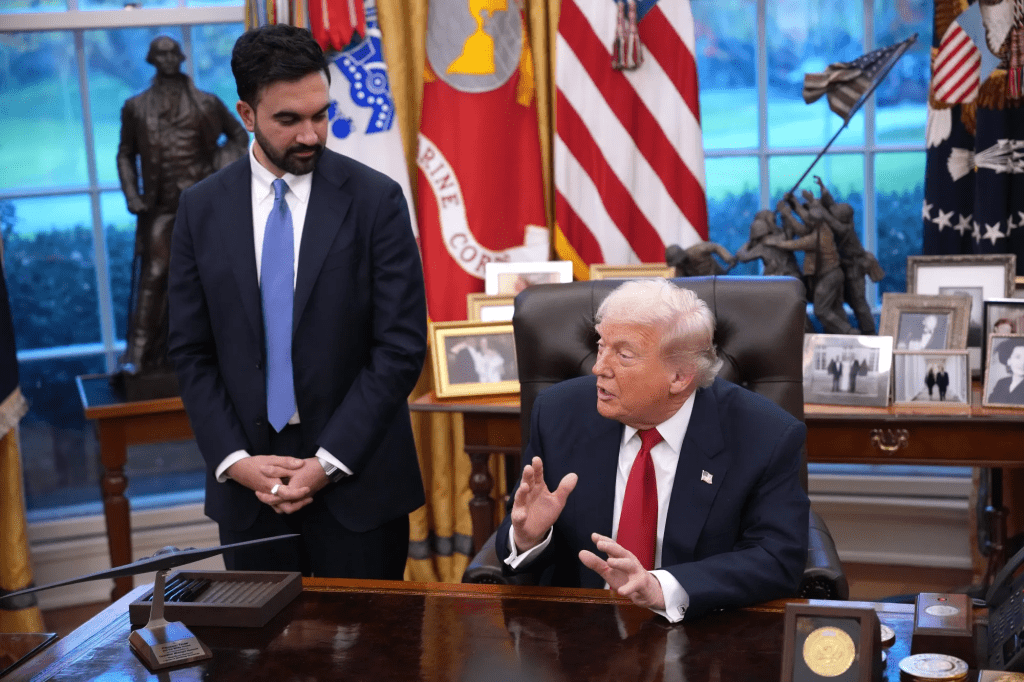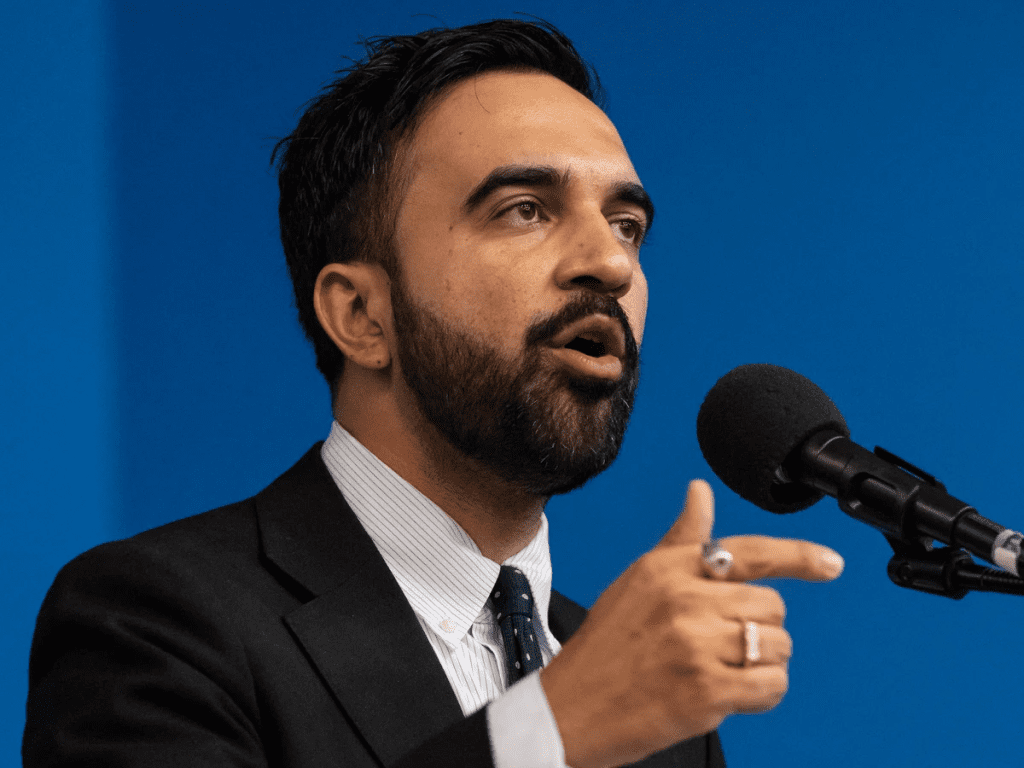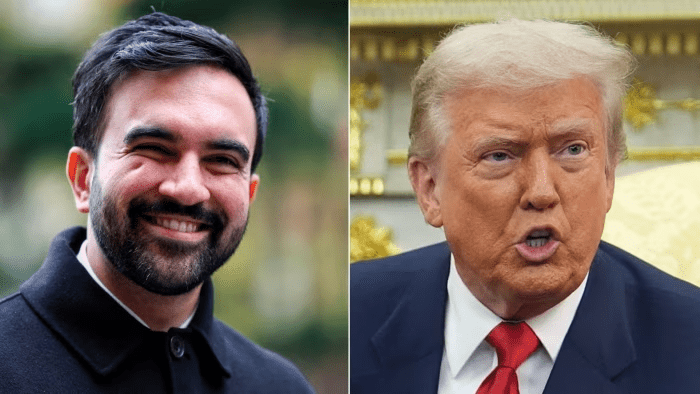Grilled on ‘White Neighborhood’ Surcharge in Tense Trump Tête-à-Tête
In the gilded confines of the Oval Office, where the November 21, 2025, sunlight streamed through the tall windows like a spotlight on an unexpected stage, Zohran Mamdani found himself not as the triumphant mayor-elect of New York City, but as the unlikely guest in a high-stakes sit-down with President Donald J. Trump, the man he’d once lambasted as a “fascist threat to democracy.” At 33, Mamdani—the democratic socialist wunderkind whose stunning November 4 victory over Eric Adams had sent shockwaves through the Empire State—arrived with the poise of a policy wonk ready to bridge divides, his dark suit and measured smile a far cry from the rally firebrand who’d rallied crowds with cries for rent control and police reform. Trump, 79 and ever the showman, greeted him with a firm handshake and that trademark grin, the room’s walls lined with portraits of past presidents bearing witness to an encounter that promised pragmatism but delivered drama. Flanked by a small press pool and conservative commentator Jack Posobiec, whose sharp questions had become a staple of MAGA media, Mamdani aimed to discuss affordability—the soaring rents and grocery bills that had propelled his win and, surprisingly, Trump’s unexpected surge in the city. But when Posobiec zeroed in on Mamdani’s controversial property tax plan—higher rates on wealthier, whiter neighborhoods—the air thickened, the mayor-elect’s responses a masterclass in evasion that left Trump chuckling and the internet ablaze, a moment that crystallized the awkward dance between progressive ideals and the hard realities of governing a city as divided as it is dynamic.

Mamdani’s path to that Oval Office armchair was anything but straightforward, a rags-to-revolution rise that mirrored the very New York grit he now seeks to govern. Born in Kampala, Uganda, to Indian Muslim academics who fled political turmoil for the bustling mosaic of Queens, Mamdani grew up in a modest Astoria apartment where halal markets and subway rumbles were the soundtrack of his childhood. By his teens, he was a precocious activist, organizing school walkouts against the Iraq War and interning for labor unions that fought for fair wages in a city where the “American Dream” often came with a eviction notice. Elected to the New York State Assembly in 2020 at 29, he quickly became the Squad’s East Coast echo, pushing bills to cap rent hikes at 3% and defund the NYPD by $1 billion, his eloquence earning him a spot on AOC’s shortlist for rising stars. The mayoral run was his moonshot: a June primary upset over establishment favorites, fueled by 70% youth turnout and promises of universal childcare and a $30 minimum wage, culminating in a November 4 runoff win with 52% to Adams’ 48%. “New York isn’t for sale,” he declared in his victory speech at Forest Hills Stadium, the crowd of 15,000 roaring as fireworks lit the night, a socialist surge that blindsided pundits and buoyed the left’s hopes for a post-Trump rebound. But affordability was his ace—the $4,000 median rent, 18% food insecurity rate, $5 billion migrant shelter tab—that resonated even in Trump-won precincts like Bay Ridge and Fresh Meadows, where working-class voters crossed lines for a leader who spoke their language of squeezed budgets.

The Oval meeting, announced by Trump on Truth Social with his signature flair—”Communist Mayor of New York City, Zohran ‘Kwame’ Mamdani, has asked for a meeting”—was billed as a pragmatic parley on the cost-of-living crisis that had upended the election. Mamdani, in a pre-meeting interview with MS Now, framed it as “speaking plainly to the president about what it means to stand up for New Yorkers,” a nod to the shared voter angst over $7 eggs and $3,500 studios that saw Trump snag 45% in the city, his best since Reagan. Trump, sipping Diet Coke from a crystal tumbler, welcomed the olive branch with uncharacteristic warmth: “Some of his ideas are the same as my ideas—he wants housing, lots of apartments built.” The room, with its Resolute Desk and presidential portraits, felt like a neutral ground, aides from both sides exchanging cards amid small talk on subways and skyscrapers. But when Posobiec, the OANN firebrand whose “fake news” takedowns have made him a Trump whisperer, seized the mic for a press Q&A, the temperature spiked. “To be clear, you’re continuing this idea of race-based property taxes,” Posobiec pressed, referencing Mamdani’s October campaign proposal for progressive property levies—higher rates on high-value homes in wealthier areas like the Upper East Side, which critics dubbed “whiter” enclaves. Mamdani, his jaw tightening beneath his neatly trimmed beard, fired back: “No.” Posobiec, undeterred, leaned in: “It’s what you said.” The mayor-elect, his voice steady but edged, clarified: “The use of the term is a description of neighborhoods, not a description of intent.” The exchange, captured on C-SPAN and clipped for viral glory, ended with Posobiec’s zinger: “So you intend to tax the whiter neighborhoods more.” Trump, watching from his chair, let out a chuckle that broke the tension like a icebreaker, his “I got a lot of votes!” a quip that lightened the load but left the left fuming.
Mamdani’s property tax pitch, unveiled in a June policy paper titled “Equity in Assessment,” was meant as a scalpel to the city’s inequality—a graduated scale hiking rates 1-2% on homes valued over $2 million, funding $2 billion for affordable housing in underserved areas like the South Bronx. “New York’s wealth is unevenly distributed—our taxes should reflect that,” he argued at a Flushing town hall, his words landing like manna for the 60% of renters spending over 30% of income on shelter. But the map he referenced—color-coded by median income and demographics—drew fire for highlighting “higher-value” zones like Tribeca and Park Slope, areas with 70-80% white populations per Census data, prompting Posobiec’s pointed probe. “It’s not race—it’s revenue,” Mamdani insisted post-meeting to reporters on the North Portico, his suit rumpled from the hour-long huddle, aides flanking him like a human shield. Yet the optics stung, especially in a city where Trump’s 2024 gains—45% citywide, 52% in Queens—were chalked up to economic exodus, white working-class voters in Staten Island and Bay Ridge flipping blue strongholds red over $4,000 rents and $15 bodega sandwiches. “Zohran’s plan taxes success, not skin,” his campaign manager, Lena Torres, told the Post in a follow-up, but for critics like Posobiec, it’s a wolf in progressive wool: “Race by any other name—still smells like discrimination.”

The Oval exchange, beamed live on Fox News and clipped for 10 million X views by midday, wasn’t just a gotcha— it was a glimpse into the grinding gears of governance, where ideals clash with invoices in a city of 8.8 million souls scraping by. For Carla Esposito, the Corona nurse who’d knocked doors for Mamdani with a fire in her belly, the clip hit like a cold compress on a fevered hope. “Zohran’s my guy—he gets the rent rip-off—but if his fix feels like it’s picking pockets by postcode, how’s that fair?” Carla asks, her scrubs still on as she stirs arroz con pollo in her one-bed walk-up, the TV flickering with the replay, her 12-year-old son munching homework at the table. Carla, whose Dominican family fled Trujillo’s tyranny for a Flushing dream that soured into $3,500 studios, voted for the socialist who promised $15 minimum and universal childcare, but the cost-of-living cut crosswise: Trump’s 45% in NYC, his best since Reagan, a surge in outer boroughs where inflation’s invisible tax hit 30% harder than Manhattan’s martini sippers. “People like us—we don’t vote ideology; we vote survival,” Carla adds, her ladle pausing mid-stir, the steam rising like a sigh of solidarity across the aisle.

Trump’s chuckle in the clip, that “I got a lot of votes!” quip, was the sound of vindication, a president whose 2024 blueprint—tariffs shielding steel but stinging soybeans, tax cuts juicing growth to 3.2%—had won the wallets even in blue bastions. Mamdani’s nod to that economic exodus—”more New Yorkers voted for Trump because of the cost-of-living”—was a concession that warmed the room, the mayor-elect owning the overlap where progressive pain meets populist promise. “Housing, food prices—Zohran’s right, it’s the squeeze that counts,” Trump said later in a Fox hit, his voice a velvet rumble, the camera catching the glint in his eye that says he’s spotted the deal in the dialogue. The meeting, part of Trump’s “state of the cities” series, wasn’t scripted for synergy; it was a summit of shared suffering, aides from both sides exchanging cards amid small talk on subways and skyscrapers. Posobiec’s probe, sharp as a stiletto, cut to the core: Mamdani’s plan, while denying racial intent, targets “higher-value” zones that skew whiter and wealthier, a progressive paradox that echoes California’s Prop 13 fights where equity meets exclusion. “It’s geography, not genetics,” Mamdani clarified to the Post, but for Posobiec, it’s a dog whistle in decibels, his X thread racking 2 million views with memes of “taxman cometh for the cul-de-sac.”

The fallout fanned flames on both flanks, progressives like AOC tweeting “Zohran’s fighting the real fight—affordability over anecdotes,” her post a 500,000-like lightning bolt, while MAGA voices like Gaetz thundered “Race-baiting by zip code—Trump called it.” For Carla, stirring that arroz with a lighter heart, Mamdani’s admission is absolution: “He’s owning it—maybe that’s the start.” In a city of 8.8 million souls, where the subway’s rumble mirrors the rumble of resentment, this Oval overlap offers a sliver of solace—a socialist and a showman finding footing on the firm ground of family budgets, a reminder that in the Empire State’s endless evolution, empathy endures.


